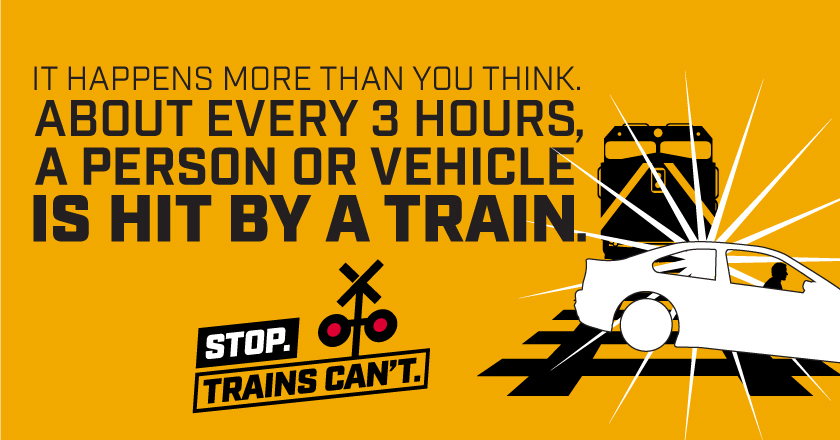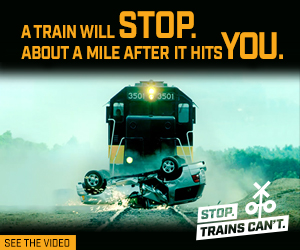
Stop.
Trains
Can't.
The
Right
Choice
at
Railroad
Crossings
Could
Save
Your
Life
Don't Risk
It
at Railroad Crossings
-
Approximately every three hours, a person or vehicle is hit by a train in the United States.
-
Most of these deaths were caused by risky driving behaviors and poor decision- making, and could have been prevented.
-
Remember:
Stop.
Trains
Can't. Avoiding a collision with a train is the responsibility of the motorist.
Trains
Always
Have
the Right
of Way
-
By law, trains have the right of way at all railroad crossings.
-
Trains cannot swerve, stop quickly, or change direction to avert collisions. A train traveling at 55 miles per hour takes a mile or more to stop.
-
State highway traffic safety laws require all motorists to slow, yield, or stop until the train has cleared the roadway and it is safe to cross.
-
It is illegal to go around a lowered crossing gate or to ignore signs or flashing lights posted at a railroad crossing.
Understand the
Signage
and Follow
the
Law
-
Of the 130,000 public railroad crossings in the United States, roughly 54 percent are "active" crossings that include warning devices such as gates, bells, or flashing lights to alert motorists of an approaching train. But 46 percent are "passive" crossings, where only signs and markings are present.
-
While warning devices do improve safety at railroad crossings, they do not prevent 100 percent of collisions. Approximately 60 percent of all collisions at railroad crossings occur where active warning devices are present, and nearly 19 percent of all crossing collisions involve a motor vehicle striking the side of a train already in the crossing.
-
Motorists must come to a complete stop at least 15 feet from the track if: 1) flashing red lights are activated, 2) a crossing gate is lowered, 3) a flagman signals you to stop, 4) a stop sign is posted, or 5) a train is clearly visible or you hear the whistle of a train.
-
Ignoring signage or attempting to go around a crossing gate that is down can have deadly consequences. It is never worth risking your life by ignoring the law or racing a train.
-
The best way to avoid a collision with a train is to understand and follow the warning signage, and to always stop for a train.
Use Caution
at Every
Railroad Crossing
-
When approaching a railroad crossing, slow down, and look and listen for a train on the tracks, especially at "passive" crossings.
-
Look carefully in both directions before crossing a railroad track—even during the day. Sixty-seven percent of railroad crossing collisions occur in clear weather conditions.
-
Do not rely on past experience to guess when a train is coming. Trains can come from either direction at any time.
-
Never race a train. It is easy to misjudge a train's speed and distance from the crossing. A train traveling at 55 miles per hour takes a mile to stop—the length of 18 football fields or more—after applying the emergency brakes.
-
Before entering a railroad crossing, check that there is enough room on the other side of the tracks for your vehicle to cross completely and safely. Be aware that you may need to cross multiple sets of tracks at some railroad crossings.
-
Never stop on the railroad tracks. Keep moving once you have entered the crossing, and to avoid stalling, never shift gears on the tracks.
-
If your vehicle does stall on a railroad track, quickly move away from the track and your vehicle at a 45-degree angle. Call the number on the Emergency Notification System (ENS) sign, or if the ENS sign is not visible to you, dial 911 for help.
Remember: The Right Choice
at
Railroad Crossings
Could Save Your Life.
Stop. Trains
Can't.
This information has been provided by NHTSA.

